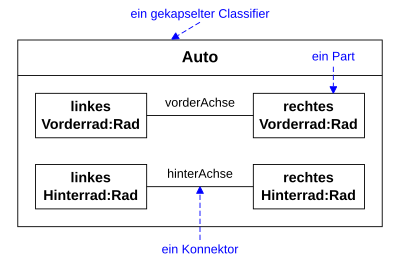Composition structure diagram
| Structure diagrams of the UML |
|---|
| Class diagram |
| Component diagram |
| Composition structure diagram |
| Object diagram |
| Package diagram |
| Profile diagram |
| Distribution diagram |
| UML behavioral diagrams |
| Activity diagram |
| Use case diagram |
| Interaction overview diagram |
| Communication diagram |
| Sequence diagram |
| Timing diagram |
| State diagram |
A composite structure diagram (Engl. Composite structure diagram ) is one of the 14 chart types in the Unified Modeling Language (UML), a modeling language for software and other systems.
The composition structure diagram shows the inside of a classifier and how it interacts with its surroundings.
part
Parts are components of the whole that belong to the whole or are composed by the whole through a compositional relationship. A part is represented using a rectangle that can have its own multiplicity . They are enclosed by the whole with a large frame. Inside the frame, the parts show their relationships using connectors with each other to, to the outside are interfaces (interfaces) offered and made available features (features) shown.
At the beginning it was suggested that a part does not necessarily have to be part of the whole, although it is needed to complete the whole. "Outside" parts can be included in the representation of the whole, but the rectangle of the outside part is dashed to distinguish it.
Connector
A connector (connector) is used to describe a communication path between instances . Instances that are connected to one another via a connector have the opportunity to interact with one another, i. H. they “know” each other at runtime. Connectors are primarily used to represent the interactions of parts.
A connector is shown with a solid, simple line, identical to an association . Like association ends, connectors also have multiplicities. These can differ from the multiplicity of the parts. In this way, a whole coherent network of parts can be displayed via the connectors.
Two specializations of the connector are the assembly connector and the delegation connector .
Composition connector
A composition connector is the connection between offered and used interfaces or ports . This indicates that a component provides services that are needed by others.
Delegation connector
A delegation connector, on the other hand, shows the connection between the “external” behavior of the component and the internal structure (parts) that realizes the behavior. These connections are always implemented via the ports, with a delegation connector always being implemented between the port of the component and the port of the part.
(Translated from: Documenting Component and Connector views with UML 2.0)
port
Ports (UML) are points of interaction at which a large number of offered and required interfaces are available. Ports can also enter into relationships with one another and thus be connected to one another in order to form a complex whole (e.g. plugging components together to form a whole).
example
The figure on the left shows a composition structure diagram with an encapsulated classifier, four parts and two connectors.
Difference from object diagrams
The difference between an object diagram and a composition structure diagram is that expression specifications (called objects in UML 1.4) can exist independently in an object diagram, whereas parts in a composition structure diagram cannot. Parts are always part of something.
Individual evidence
- ↑ Documenting Component and Connector views with UML 2.0 ( English , PDF) SEI Joint Program Office. Archived from the original on September 12, 2012. Retrieved June 13, 2019.
- ↑ Oliver Alt: Model-based system development with SysML . Carl Hanser Verlag, 2012, Section 4.4.3 Special Instances: Parts
literature
- Christoph Kecher: UML 2.0 - The comprehensive manual . Galileo Computing, 2006, ISBN 3-89842-738-2
- Heide Balzert: Textbook of Object Modeling - Analysis and Design with UML 2 . Elsevier Spectrum Academic Publishing House, 2005, ISBN 3-8274-1162-9
- Marc Born, Eckhardt Holz, Olaf Kath: Software development with UML 2 . Addison-Wesley Verlag, 2003, ISBN 3-8273-2086-0
- Bernd Oestereich : The UML 2.0 short reference for practice . 3rd edition, Oldenbourg Verlag, 2004, ISBN 3-486-27604-2
- OMG: UML 2.0 Superstructure Specification . OMG, August 2, 2003, pct / 03-08-02
Web links
- OMG UML The official UML specification
- UML 2.4.1 Notation overview (PDF; 132 kB)
